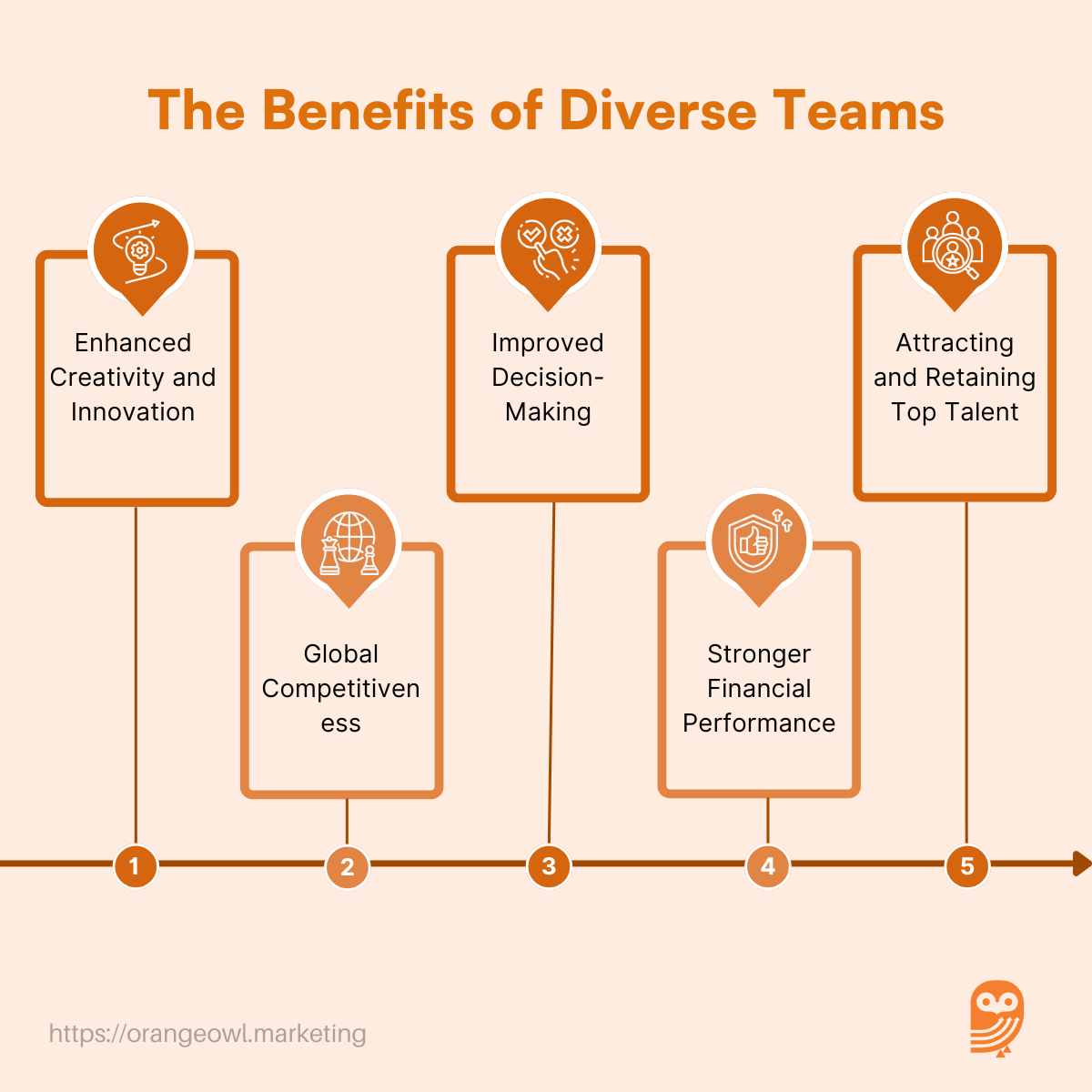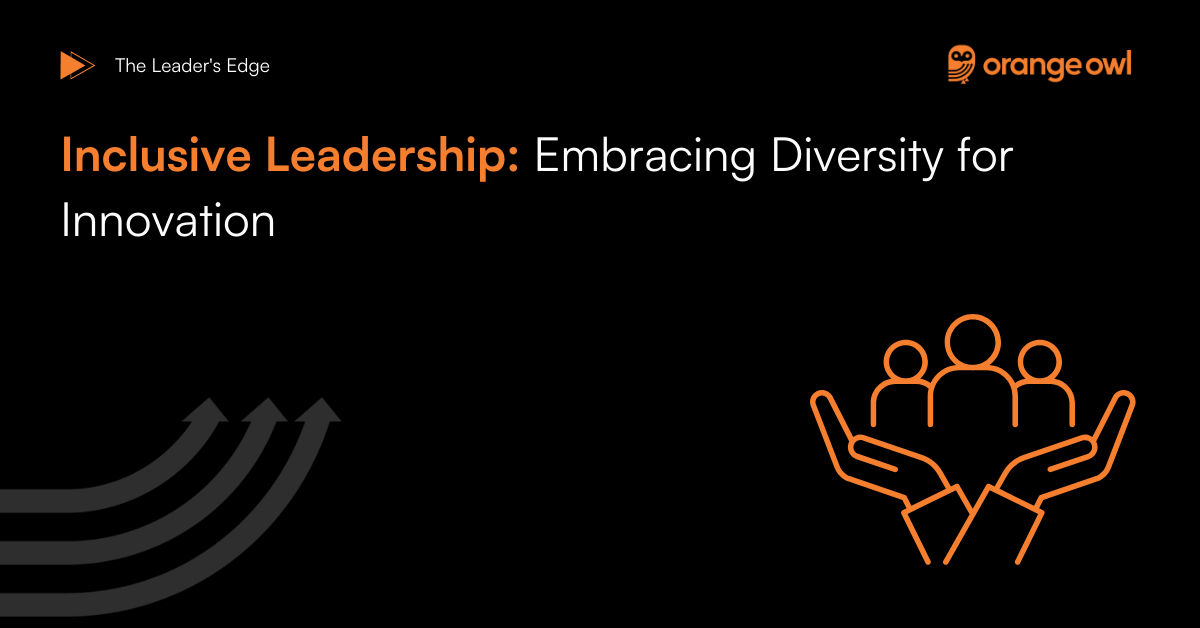At Orange Owl, we’ve seen firsthand how diverse teams bring unique ideas and fresh perspectives that spark creativity and lead to groundbreaking solutions. From small startups to mid-sized businesses, fostering a culture of inclusivity can transform not only the internal dynamics of a company but also its ability to thrive in competitive markets.
What is Inclusive Leadership?
Inclusive leadership is the practice of leading with fairness, openness, and a commitment to embracing diverse perspectives. It involves actively seeking out and valuing contributions from individuals of all backgrounds, ensuring that everyone feels respected and empowered to bring their full selves to work.
This leadership style drives collaboration, innovation, and better decision-making by leveraging the unique strengths of a diverse team.
Tech Industry: In a software development company, an inclusive leader might assemble a project team that includes individuals with varying technical specializations, cultural backgrounds, and gender identities. By creating an environment where all voices are heard, the leader ensures the final product is innovative and globally relevant.
Retail Industry: A retail chain’s inclusive leader might implement flexible schedules and accessible hiring practices to accommodate employees with disabilities, creating an equitable work environment. This approach not only enhances employee satisfaction but also broadens the company’s appeal to a diverse customer base.
Healthcare Industry: In healthcare, an inclusive leader might advocate for multilingual staff to better serve a diverse patient population, ensuring that cultural and linguistic barriers don’t impede quality care. This fosters trust and improves patient outcomes.
Inclusive leadership goes beyond tolerance; it’s about actively celebrating differences, recognizing the value of varied perspectives, and creating opportunities for everyone to thrive.
The Benefits of Diverse Teams
Enhanced Creativity and Innovation
Diverse teams bring together individuals from different backgrounds, experiences, and perspectives, which fosters a culture of creativity. Research has shown that diversity drives innovation because teams with varying viewpoints can approach challenges from multiple angles, leading to more creative solutions. According to a study by the Harvard Business Review, companies with diverse leadership are 45% more likely to report market share growth and 70% more likely to capture new markets.
Improved Decision-Making
Homogeneous teams may reach consensus more quickly, but diverse teams make better decisions. When people with different experiences and perspectives come together, they challenge each other’s ideas, leading to more robust and thoughtful decision-making. Diverse teams are able to avoid groupthink, consider all aspects of a problem, and arrive at decisions that are more likely to succeed.
Attracting and Retaining Top Talent
A company that values diversity is more likely to attract top talent. Employees are more likely to join and stay with organizations where they feel included and appreciated for their unique contributions. A diverse and inclusive workplace also enhances employee satisfaction, reducing turnover rates and improving the organization’s reputation as a desirable place to work.
Global Competitiveness
In an increasingly globalized economy, having a workforce that mirrors the diversity of the marketplace gives companies a competitive edge. A diverse team can better understand and cater to the needs of a wide range of clients and customers, enabling businesses to expand into new markets and regions.
Stronger Financial Performance
Numerous studies have linked diverse leadership teams to superior financial performance. Companies with higher levels of diversity in leadership positions have been shown to outperform their peers in terms of profitability. McKinsey’s 2020 Diversity Wins report found that companies in the top quartile for gender diversity on executive teams were 25% more likely to have above-average profitability than companies in the bottom quartile.

Practical Tips for Creating an Inclusive Workplace Culture
Foster Open Communication
Encouraging open communication is vital to building an inclusive workplace. Leaders should create safe spaces where employees feel comfortable sharing their thoughts, ideas, and concerns. This can be done through regular feedback sessions, one-on-one meetings, and team-building activities that promote honest dialogue.
Provide Diversity and Inclusion Training
Offering diversity and inclusion (D&I) training can help employees understand unconscious biases and cultural differences. This can improve collaboration among team members and create a more empathetic and respectful work environment. Training programs should be ongoing and tailored to the specific needs of the organization.
Promote Inclusive Leadership
Inclusive leadership starts at the top. Leaders must model inclusive behaviors, such as actively listening to diverse perspectives, recognizing and mitigating bias, and ensuring that all voices are heard. Inclusive leaders are empathetic, transparent, and committed to continuous learning.
Create Diverse Teams
Ensure that teams are composed of individuals with diverse backgrounds, skills, and perspectives. By promoting cross-functional collaboration and creating opportunities for employees from different departments and levels to work together, you foster an environment where diverse ideas and solutions can flourish.
Support Employee Resource Groups (ERGs)
Employee resource groups, such as those focused on gender, ethnicity, or LGBTQ+ inclusion, provide valuable support networks within the organization. They allow employees to connect with others who share similar experiences and offer a platform for discussing issues and advocating for change. Supporting ERGs can help build a sense of belonging and empower underrepresented groups.
Implement Fair Hiring Practices
A truly inclusive workplace starts with the hiring process. Implement fair and unbiased hiring practices by using diverse hiring panels, anonymized resume reviews, and structured interviews. Ensure that job postings and career advancement opportunities are accessible to individuals from all backgrounds.
Recognize and Celebrate Diversity
Take the time to recognize and celebrate the diversity within your organization. This could include acknowledging cultural holidays, hosting events that highlight different traditions, and recognizing employees who actively contribute to building an inclusive workplace.
Measure and Track Progress
Lastly, it’s important to track your organization’s progress in building an inclusive culture. Use diversity metrics, employee feedback, and inclusion surveys to measure success and identify areas for improvement. Setting clear goals for diversity and inclusion ensures accountability and continuous progress.
Conclusion
Inclusive leadership is not just a moral imperative—it’s a strategic advantage. By embracing diversity and fostering an inclusive culture, organizations can drive innovation, attract top talent, and outperform their competitors. Leaders must be proactive in creating an environment where every individual is empowered to contribute their best, ensuring that diverse teams thrive and lead to the success of the entire organization.
Building an inclusive workplace is an ongoing journey, but by taking these practical steps, companies can unlock the full potential of their teams and drive meaningful, sustainable growth.



